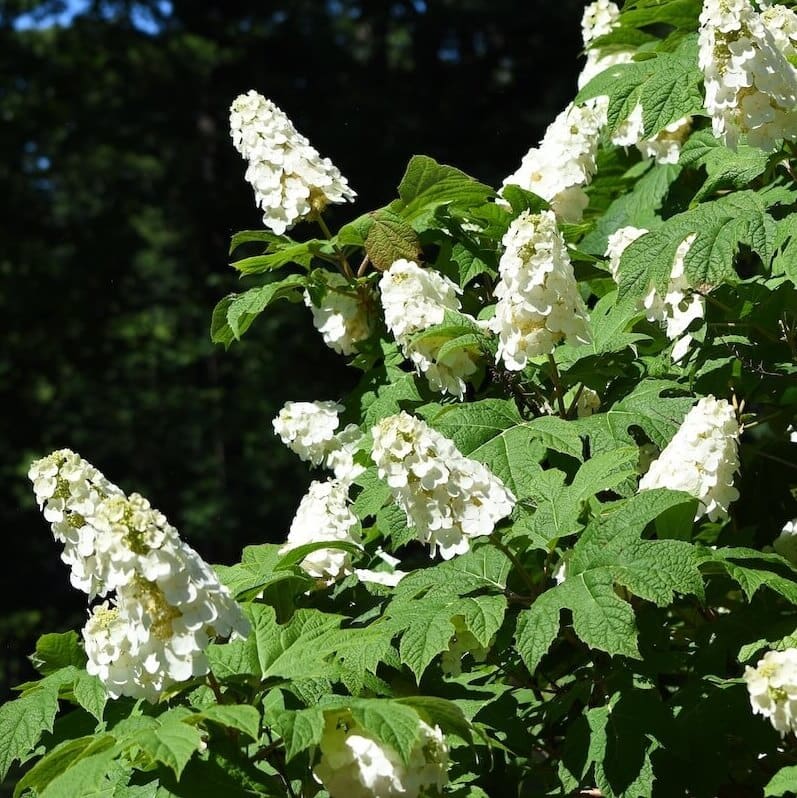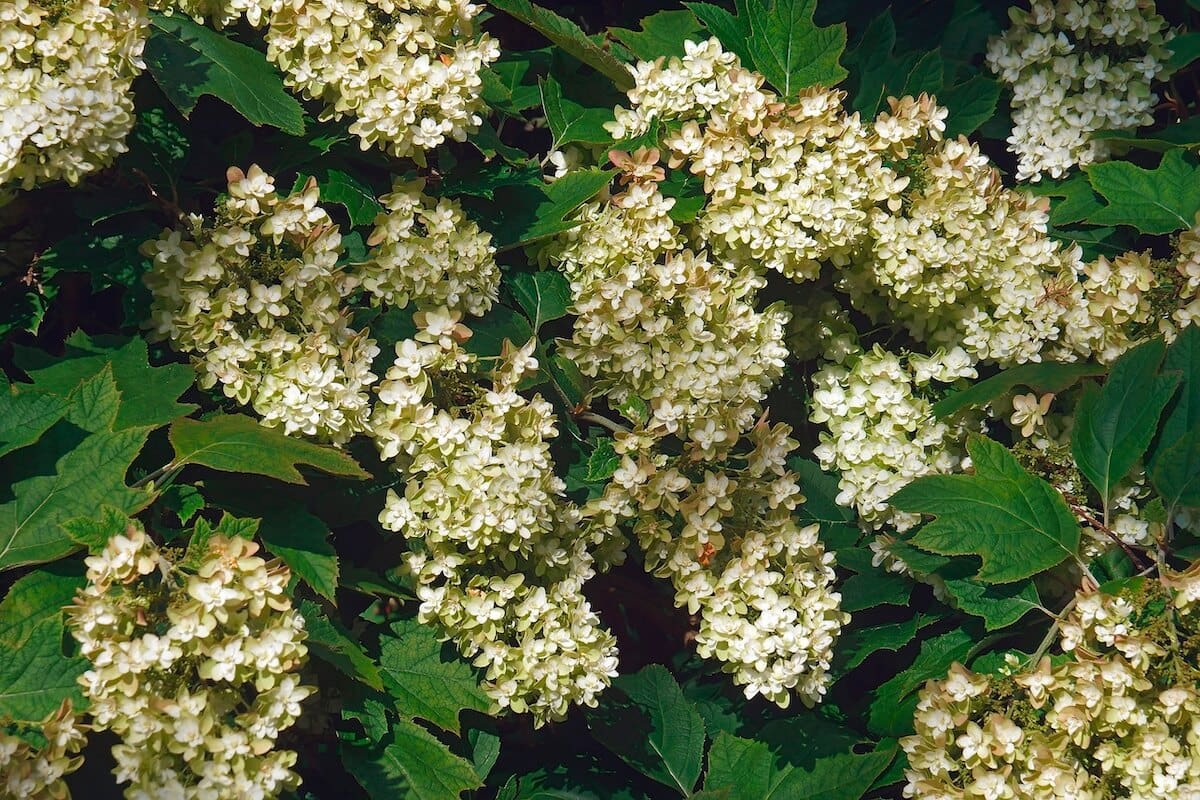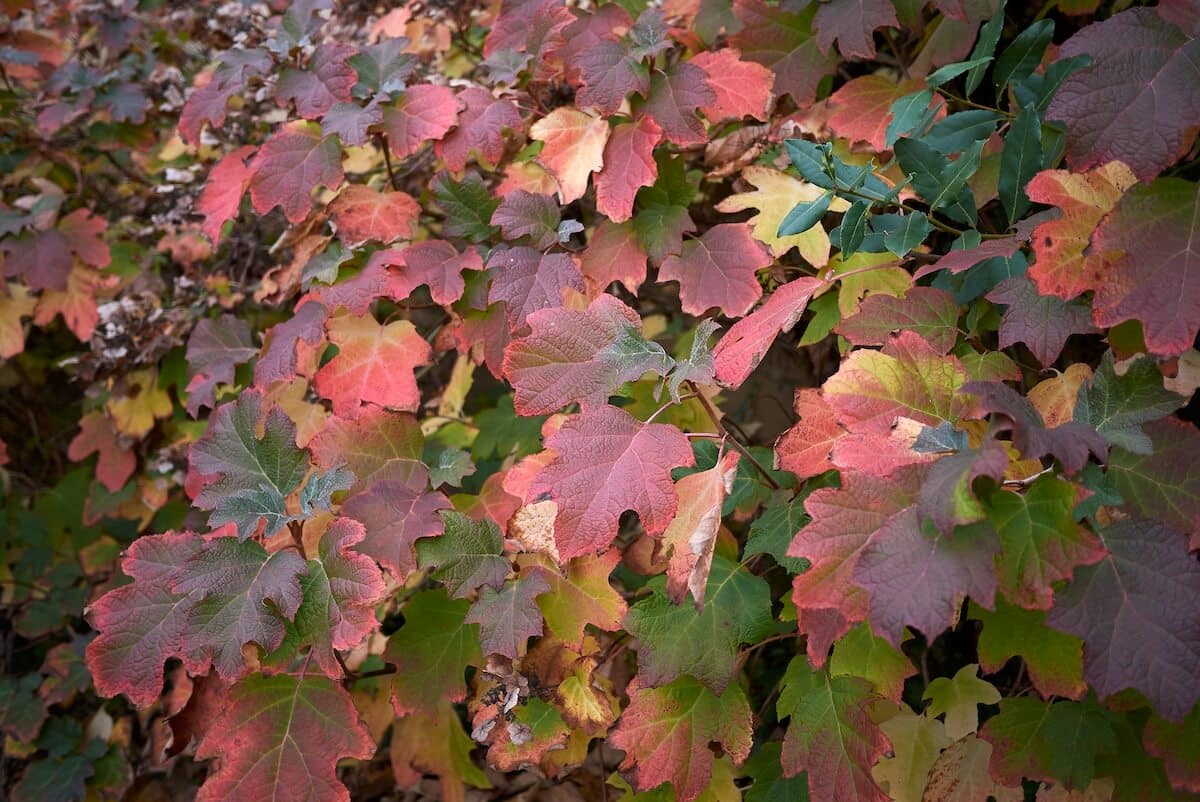
Position
- Partial shade to full sun
- Protected from strong winds
- Morning sun with afternoon shade ideal
- North or east-facing aspects
- Woodland garden settings excellent
Hardiness
- Hardy down to -15°C (5°F)
- Young growth susceptible to late spring frosts
- More cold-hardy than mophead hydrangeas
- Winter protection needed for young plants
Soil Type
- Moist but well-drained soil
- Rich in organic matter
- Loamy soil ideal
- Can tolerate clay if improved
- Avoid waterlogged conditions
Soil PH
- Adaptable to pH 5.5-7.5
- Performs well in neutral soil
- Tolerates slightly acidic conditions
- Flower colour is not affected by pH
- More tolerant of alkaline soils than other hydrangeas
- Grab a soil test kit and ensure the perfect conditions for growth
Height
- Height: 1.8-2m (6-7ft)
- Spread: 1.5-2.5m (5-8ft)
- Growth rate moderate
- Can be kept smaller with pruning
Seasons of Interest
- Flowering: July to September
- White conical flowers ageing to pink/bronze
- Spectacular autumn foliage in red and purple
- Winter interest from dried flower heads
- Spring leaf emergence with bronze tints
- Oak-like leaves provide summer texture
Additional Notes
- Minimal pruning required – just remove dead/damaged growth
- Excellent for dried flower arrangements
- Drought-tolerant once established
- Benefits from annual spring mulching
- Good companion for woodland plants
- Can be grown in large containers
- Flowers appear on the previous year’s wood
- More disease resistant than other hydrangeas
- Attracts pollinators
- Good choice for coastal gardens
- Peeling bark adds winter interest
- Perfect for shady borders
- Low maintenance once established
- Named for the oak-like leaf shape
- Seed heads provide winter food for birds
- Good autumn structure in the garden
- Suitable for informal hedging
Hydrangea Quercifolia ‘Snow Queen’: A Stunning Shrub for All Seasons
The oak-leaved hydrangea ‘Snow Queen’ (Hydrangea quercifolia) knows how to make an impression. Its bold, cone-shaped flowers and standout foliage bring something special to the garden all year round. In summer, you get a stunning show of white blooms, and come autumn, the leaves display fiery colour. Whether you’re a seasoned gardener or just getting started, this guide will walk you through everything you need to know. What makes this shrub so different is how it blends dramatic flowers with gorgeous seasonal leaf changes—perfect if you want a plant that works hard and looks great every season.
Why Is Oak-Leaved Hydrangea So Special?
Hydrangea quercifolia ‘Snow Queen’ gets its name from those lovely, deeply lobed leaves that look just like oak leaves. It comes from the southeastern United States and brings a lot to the garden all year round. It puts on a big show in summer with its large, cone-shaped clusters of creamy white flowers that pop against the deep green foliage.
But it doesn’t stop there. As the flowers age, they take on soft pink and bronze tones, and then autumn arrives with a whole new layer of colour—think deep reds, purples, and bronzes. It’s a real eye-catcher! Even when winter rolls in, the interest continues. The bark peels in strips of cinnamon brown, and those dried flower heads hang on, adding texture and structure through the colder months.
‘Snow Queen’ is not just a pretty face—it’s tough, adaptable, and full of seasonal surprises. Perfect if you want something that looks good, no matter the time of year.
Where’s the Best Spot to Plant It?
Hydrangea quercifolia ‘Snow Queen’ is pretty adaptable, but it shines in a spot with morning sun and some shade in the afternoon. It can handle full sun, but if it gets too intense midday heat, the leaves might scorch. A bit of dappled light—like you’d find in a woodland setting—is perfect. The trick is finding the right balance: enough light for those big, beautiful flowerheads to form, but not so much that the plant gets stressed out.
Look at how the sun moves through your garden during the day—and even through the seasons—before you choose a spot. Ideally, please give it a position where you’ll enjoy the summer blooms and the show-stopping autumn colour.
Also, remember that ‘Snow Queen’ isn’t a little plant forever. It can grow up to around 2 metres tall and wide, so give it room to spread out. Think about how it’ll look from your windows, patios or garden paths—it makes a great focal point when the leaves start turning those rich burgundy and bronze shades. It might look small when you first plant it, but give it space and it’ll reward you in all the right ways.

What Kind of Soil Does Hydrangea Quercifolia ‘Snow Queen’ Like?
‘Snow Queen’ hydrangeas do best in moist, well-drained soil rich in organic matter. Unlike mophead hydrangeas, their flower colour doesn’t shift with soil pH, so you’ll get consistent blooms no matter your soil type. The key is to keep the roots damp without letting them sit in water. If you’ve got heavy clay, mix in some horticultural grit and compost to loosen things up. Sandy soil? Add plenty of organic matter to help it hold on to moisture.
Dig in lots of compost or well-rotted manure to improve drainage and water retention when planting. A top-up mulch—compost, composted bark, or leaf mould—is a great way to feed the soil and keep moisture levels steady. Aim for a planting depth of at least 45cm to give the roots plenty of room. If you want to give your plant a head start, sprinkle in some mycorrhizal fungi to help it settle in and soak up nutrients more efficiently.
When and How Should I Plant Hydrangea Quercifolia ‘Snow Queen’?
The best time to plant your ‘Snow Queen’ is during the dormant months—either in late autumn or early spring. This gives the roots time to settle in before the big push of summer growth. Autumn planting is often easier, with warm soil and less watering needed, while spring is a good choice to avoid any risk of winter damage.
Start by digging a hole twice as wide as the root ball, and mix in lots of compost or well-rotted manure to help the plant get off to a good start. Plant it at the same depth it grew in its pot, then give it a good soak to settle the roots. Add a thick layer of mulch to help keep the moisture in, but keep it away from the base of the stem to stop it rotting.
If you’re planting more than one, leave about 1.5 to 2 metres between them so they’ve got plenty of space to grow. Ensure the sides of your planting hole are rough, not smooth like a bucket, so the roots can easily spread into the surrounding soil. You can also add a handful of bone meal or slow-release fertiliser to boost it. After planting, keep the watering steady through the first growing season to help it get established.
How Do You Care for Oak-Leaved Hydrangea ‘Snow Queen’?
The good news is, ‘Snow Queen’ doesn’t need much pruning. If you want to tidy it up, the best time is late winter, just before new growth starts. Snip out dead or damaged branches, and take out a few older stems to make room for fresh shoots. There’s no need to go heavy with the secateurs—just aim to keep the plant’s natural shape, which is part of what makes it so striking. If you remove no more than a third of the oldest stems each year, you’ll keep it healthy and blooming beautifully without losing the current season’s flowers.
When it comes to watering, a little consistency goes a long way. These hydrangeas are fairly drought-tolerant once settled in, but they’ll do best with regular moisture, especially in hot weather. Water deeply but not too often, so the roots grow down rather than staying near the surface. Avoid spraying the leaves and aim for the base of the plant to help prevent disease. If you’re facing a dry spell, a soaker hose or drip irrigation can make things easier. Keep an eye on the soil, particularly during the first few years and while the plant is flowering—it’s worth the effort for those show-stopping blooms.
How Can I Get the Best Autumn Colour from ‘Snow Queen’?
One of the best things about ‘Snow Queen’ is its impressive autumn display—but a few simple tweaks can help it shine. If you want the richest reds and purples, try planting it somewhere with some dappled or light shade. Plants in partial shade often show off the best colour.
The weather plays a big part, too. Cool nights and sunny days are the perfect combo for bold autumn tones. That’s when the plant produces the pigments that turn the leaves deep purples and reds. Make sure your hydrangea has enough space around it so light can reach the whole plant—this helps it develop even colour across the foliage.
Keeping the soil consistently moist (but not soggy) also supports a significant colour change, especially after a warm summer. Planning goes a long way to get the most from your plant’s autumn show.

Does ‘Snow Queen’ Need Any Winter Care?
Once established, ‘Snow Queen’ is tough and can handle most UK winters to around -10°C (14°F). But younger plants—especially in exposed spots—will appreciate a bit of extra protection when the cold sets in.
In late autumn, pile on a thick layer of mulch around the base of the plant. Aim for about 7–10cm deep and spread it out past the edges of the canopy. Mulch helps keep the roots snug and stops the soil from freezing and thawing too quickly, which can push the roots up and cause damage. Go for natural stuff like straw, leaf mould, or composted bark—they’ll break down over time and feed the soil too.
If the forecast looks particularly frosty, you can wrap your hydrangea in horticultural fleece to protect those flower buds for next year. This is especially useful for young plants or ones in breezy, open spots. By the time your hydrangea’s well established, it’ll cope better, but a fresh mulch each year is still an excellent idea for overall plant health.
One last tip—don’t forget to check soil moisture, even in winter. A prolonged dry spell can cause as much trouble as a cold snap, so water occasionally if things stay dry.
How Can I Use ‘Snow Queen’ in My Garden?
‘Snow Queen’ is one of those shrubs that fits almost anywhere. With its bold leaves, striking flowers, and brilliant autumn colour, it’s a real showstopper whether you plant it as a standout feature or blend it into a mixed border.
Its natural, slightly wild shape looks great in woodland-style gardens or more relaxed planting schemes. The big leaves bring lovely contrast next to finer-leaved plants, and those cone-shaped blooms add a bit of height and drama. You could pop one in a shady corner to brighten things up or use it to lead the eye in a layered planting design.
If you’ve got the space, try grouping a few for a lush look. In smaller gardens, just one well-placed plant can be a stunning focal point—especially if you can see it from a patio or window.
For planting partners, think shade lovers like ferns, hostas, or grasses that won’t fight for the spotlight but will complement the hydrangea’s bold style. The white flowers also look gorgeous alongside dark foliage and practically glow in the evening light, so they’re great in spots where you sit out at dusk.
You can also use ‘Snow Queen’ to gently separate parts of your garden or anchor the corners of a bed. However you use it, this plant earns its keep all year round.
What Problems Might I Run Into with Hydrangea quercifolia ‘Snow Queen’?
Overall, the oak-leaved hydrangea is tough, but there are a few issues to watch for. It can sometimes get leaf spot or powdery mildew in damp, humid weather. Leaf spot shows up as brown or purple spots on the leaves, while powdery mildew looks like a white, powdery dust on the foliage. To help prevent these, make sure your plant has good airflow by spacing it well and pruning when needed. Also, avoid watering from above, especially late in the day, because wet leaves overnight make it easier for fungi to take hold. If mildew does appear, treat it with a suitable fungicide to keep it under control.
Late spring frosts can damage new growth, so watch the weather and protect your plant if frost is expected. While ‘Snow Queen’ usually doesn’t attract many pests, aphids and spider mites might occasionally appear. Check your plant regularly and deal with any bugs quickly—using insecticidal soap is an effective and gentle way to control aphids. Keeping your plant healthy also helps prevent many problems.
Be careful with watering and drainage because root rot can develop if the soil stays too soggy. If your leaves start turning yellow, it could be an iron deficiency, which often happens in very alkaline soils. A specialised fertiliser for acid-loving plants, can help fix this issue and keep your hydrangea looking its best.
From Darren’s Patch
From my garden, I can honestly say Hydrangea quercifolia ‘Snow Queen’ has become one of my favourite shrubs to grow. I love how it delivers interest through every season—from those striking white summer blooms to the fiery autumn leaves and even the textured bark in winter. It’s a reliable, low-fuss plant that feels at home in a woodland-style setting or mixed borders. I often pair mine with ferns and hostas for a lush, natural look that’s easy to maintain but always impressive. If you want a shrub that rewards you year after year with colour, structure, and character, ‘Snow Queen’ is a brilliant choice—trust me, it’s well worth making space for in your garden.
![]()
Key Points to Remember:
- Choose a location with partial shade and protection from harsh afternoon sun
- Plant in moist, well-drained soil rich in organic matter
- Minimal pruning required – focus on removing dead or damaged growth
- Water consistently during the growing season
- Mulch annually to retain moisture and suppress weeds
- Protect young plants from severe winter weather
- Allow adequate space for mature growth
- Watch for signs of leaf spot or powdery mildew
- Appreciate the spectacular autumn colour display
- Use as a specimen plant or in woodland gardens
Hydrangea quercifolia ‘Snow Queen’ is a stunning, low-maintenance shrub that brings year-round interest with its bold leaves, striking flowers, and beautiful autumn colours. Whether adding a dramatic focal point or filling a shady spot in your garden, this versatile plant will surely impress. With some care and the right conditions, ‘Snow Queen’ will thrive and reward you with seasons of colour and texture to enjoy.
To go back to the Hydrangeas page, click here
To see the RHS page on Hydrangeas, click here
From one beauty to another — take a look at Hydrangea paniculata Vanille Fraise.
For more information on Shrubs, please click here.
Frequently Asked Questions
Q: What is Hydrangea quercifolia?
A: Hydrangea quercifolia, often called Oak-leaved Hydrangea, is a striking shrub featuring distinctive oak-like leaves and stunning flower clusters, making it a popular addition to many gardens.
Q: How do I care for Hydrangea quercifolia?
A: To keep your Hydrangea quercifolia healthy, plant it in a well-drained spot and provide partial shade. Regular watering, particularly during dry periods, is essential.
Q: Can I buy Oak-leaved Hydrangea (Hydrangea quercifolia) online?
A: Absolutely! You can purchase Oak-leaved Hydrangea (Hydrangea quercifolia) from SwiftPlants.com, reputable garden centres or other online retailers. If you’re after the ‘Snowflake’ variety, check this before purchasing.
Q: What do the leaves of Hydrangea quercifolia look like?
A: The leaves are deeply lobed, mid-green, and resemble those of an oak tree. During autumn, they transform into stunning shades of red and purple, adding vibrant colour to your garden.
Q: Are there any risks associated with Hydrangea quercifolia?
A: Yes, the leaves and flowers can be toxic if ingested. Additionally, some people may experience skin irritation when handling the plant. Always wear gloves and wash your hands after gardening.
Q: What type of soil is best for growing Hydrangea quercifolia?
A: Hydrangea quercifolia thrives in well-drained soil with a slightly acidic to neutral pH. Testing your soil before planting is a good idea to ensure optimal conditions.
Q: What do the Hydrangea quercifolia ‘Snowflake’ flowers look like?
A: The flowers are displayed in eye-catching conical panicles, with sterile florets creating an impressive show. They bloom during summer and retain their charm for an extended period.
Q: Can Hydrangea quercifolia grow in a shaded area?
A: Yes, this shrub prefers partially shaded locations. While it can tolerate some sunlight, it flourishes in woodland settings or gardens with dappled shade.
Q: What pests or diseases should I watch out for with Hydrangea quercifolia?
A: Be alert to honey fungus, which can damage your plant. Regular monitoring and good gardening practices will help maintain the health of your shrubs.
